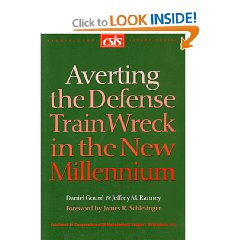Review: The Vulnerability of Empire (Cornell Studies in Security Affairs)
5 Star, Empire, Sorrows, Hubris, BlowbackReview: Toxin (Fiction)
5 Star, Disease & Health, Threats (Emerging & Perennial)Review: Preparing America’s Foreign Policy for the 21st Century
5 Star, DiplomacyFrom Gaddis Smith and Walter Mondale to Sam Nunn and Robert Oakley, from David Gergen to David Abshire to David Boren, from Kissinger to Brzezinski to Kirkpatrick, in combination with a whole host of lesser known but equally talented practitioners, capped off by comments from five Directors of Central Intelligence, this books sets a standard for organized high quality reflection on the future of U.S. foreign policy.
Most interestingly, there is general consensus with David Abshire's view that we are in a strategic interregnum, and still lacking for a policy paradigm within which to orchestrate our varied efforts to define and further our vital interests.
David Gergen clearly articulates the shortfalls in our national educational, media, and political patterns that leave the vast majority of Americans ignorant of our foreign interests and unsupportive of the need for proactive engagement abroad. Reading this book, I could not help but feel that our national educational system is in crisis, and we need both a wake-up call and a consequent national investment program such as occurred after the first Sputnik launch.
David Boren is clearly a decade or more ahead of most current commentators in his call for a new paradigm, for a new analytical framework, for the internationalization of American education across the board. I am reminded of the quotation from early America: “A Nation's best defense is an educated citizenry.” Interestingly, he cites Daniel Boorstein's caution that we must not confuse information with knowledge, and in the next sentence notes: “I watched during my term as chairman of the Senate Intelligence Committee while the CIA greatly increased its information, its raw data, but became overwhelmed and unable to separate the important from the unimportant.”
I would itemize just a few of the many, many useful insights that this book offers:
1) Diplomacy is the sum total of familiarity with the role, knowledge of the component parts of the overall national security policy, and the ability to design and implement comprehensive policies that achieve the national objectives;
2) Politicians and policy-makers are losing the ability to think objectively and act with conviction…they are too dependent on short-term domestic polling and opinion;
3) (Quoting Donald Kegan): Power without the willingness to use it does not contribute to world peace;
4) We must strengthen the domestic roots of national power if we are to have a sound strategy;
5) Future of U.S. education and strength of U.S. family unit will quite simply determine whether U.S. can meet the economic challenges of the 21st Century;
6) Our domestic insecurity and domestic violence-and resulting foreign perceptions and disrespect for our competence at home-reduce our effectiveness overseas;
7) U.S. is its own worst enemy, with declining attention to foreign policy matters;
8) Weapons of mass destruction are our only substantive vital interest today;
9) Hunger, pestilence, and refugees within Africa will affect all nations;
10) Corruption has replaced guerrilla movements as the principal threat to democratic governance;
11) Commerce rather than conflict will be the primary concern of 21st century foreign policy;
12) The environment joins trade and commerce as an essential objective for foreign policy;
13) Long-term non-military challenges, and especially global financial markets, require refocusing of our security perspectives;
14) Asia will edge out Europe as our primary trading partner;
15) China in Asia and Turkey in the West are linch-pin nations;
16) NATO will survive but we must take care not to threaten Russia;
17) The UN is not very effective at peacekeeping operations-it is best confined to idea exchanges;
18) Our military is over-extended and under-funded but still the best in the world;
19) For the cost of one battalion or one expensive piece of military equipment, one thousand new Foreign Service officers could be added toward preventive diplomacy;
20) Lessons from the Roman empire: its decline results in part from a loss of contact with its own heartlands, a progressive distancing of the elite from the populace, the elevation of the military machine to the summit of the power hierarchy, and blindness in perceiving the emergence of societies motivated by nationalism or new religious ideologies; and
21) We may need a new National Security Act.
If I had one small critical comment on the book is would be one of concern-concern that these great statesmen and scholars appear-even while noting that defense is under-capitalized-to take U.S. military competence at face value. I perceive a really surprising assumption across a number of otherwise brilliant contributions to the effect that we do indeed have all that we need in the way of information dominance, precision firepower, and global mobility (strategic lift plus forward presence)-we just need to use it with greater discretion. I do not believe this to be the case. I believe-and the Aspin-Brown Commission so stated-that we lack effective access to the vast range of global multi-lingual open sources; that our commitment to precision munitions is both unaffordable and ineffective (we ran out in 8 days in the Gulf, in 3 days in Kosovo); and that we fail terribly with respect to mobility-naval forces are generally 4-6 days from anywhere, rather than the necessary 24-48 hours. This book is a very fine starting point for the national dialogue that must take place in 2001 regarding our new national security strategy.

Review: Water–The Fate of Our Most Precious Resource
5 Star, Water, Energy, Oil, ScarcityReview: Preventive Defense–A New Security Strategy for America
5 Star, Diplomacy, Force Structure (Military)Interesting side notes include 1) the early discovery in US-Russian military discussions that technology interoperability and future collaboration required the surmounting of many obstacles associated with decades of isolated (and often secret) development; 2) the absence of intelligence from the entire book-by this account, US defense leaders spend virtually all of their time in direct operational discussions with their most important counterparts, and there is very little day to day attention to strategic analysis, estimative intelligence, or coordination with diplomatic, economic, and law enforcement counterparts at home; 3) the difficulty of finding a carrier to send to Taiwan at a time when we had 12 carriers-only four appear to have been “real” for defense purposes; and 4) the notable absence of Australia from the discussion of security in Asia.
The concept of Preventive Defense is holistic (requiring the simultaneous uses of other aspects of national power including diplomacy and economic assistance) but places the Department of Defense in a central role as the provider of realigned resources, military-to-military contacts, and logistics support to actual implementation. Unfortunately the concept of Preventive Defense has been narrowly focused (its greatest success has been the dismantling of former Soviet nuclear weapons in the Commonwealth of Independent States), and neither the joint staff nor the services are willing to give up funds for weapons and manpower in order to make a strategy of Preventive Defense possible.
This resistance bodes ill for the other half of the 21st Century security challenge, what the author's call the “C List”-the Rwandas, Somalias, Haitis and Indonesias. They themselves are unwilling to acknowledge C List threats as being vital to U.S. security in the long-term (as AIDS is now recognized). I would, however, agree with them on one important point: the current budget for defense should be repurposed toward readiness, preparing for the future, and their concept of preventive defense, and it should not be frittered away on “C List” contingencies-new funds must be found to create and sustain America's Preventive Diplomacy and its Operations Other Than War (OOTW) capabilities. It will fall to someone else to integrate their concept of Preventive Defense with the emerging concepts of Preventive Diplomacy, International Tribunals, and a 21st Century Marshall Plan for the festering zones of conflict in Africa, Arabia, Asia, and the Americas–zone where ethnic fault lines, criminal gangs, border disputes, and shortages of water, food, energy, and medicine all come together to create a breeding ground for modern plagues that will surely come across our water's edge in the future. On balance, through, this book makes the top grade for serious bi-partisan dialogue, and they deserve a lot of credit for defining solutions for the first half of our security challenges in the 21st Century.

Review: Averting the Defense Train Wreck in the New Millennium (CSIS Report)
4 Star, Budget Process & Politics, Force Structure (Military), Military & Pentagon PowerWhere the book does not go, and a companion book by the same authors would be of great value, is into the detail of
WHAT threat,
WHAT force structure.
They accept, for example, the Navy's 304-ship Navy that keeps adding gigantic carriers and does nothing for littoral warfare or putting Marines within 24 hours of any country instead of 6 days.
Similarly, they accept Air Force emphasis on fewer and fewer bigger and more sophisticated platforms of dubious utility in a 21st Century environment that requires long loiter, ranges of several hundred nautical miles without refueling, full lift in hot humid weather, and survivability in the face of electromagnetic weapons in the hands of thugs.
This book demonstrates a clear mastery of defense economics, and it is an important contribution to the bottom line: our national defense is desperately underfunded, and this must be in the “top three” issues facing the 43rd President and the 107th Congress.
What we buy, and why, has not yet been answered to my satisfaction.









